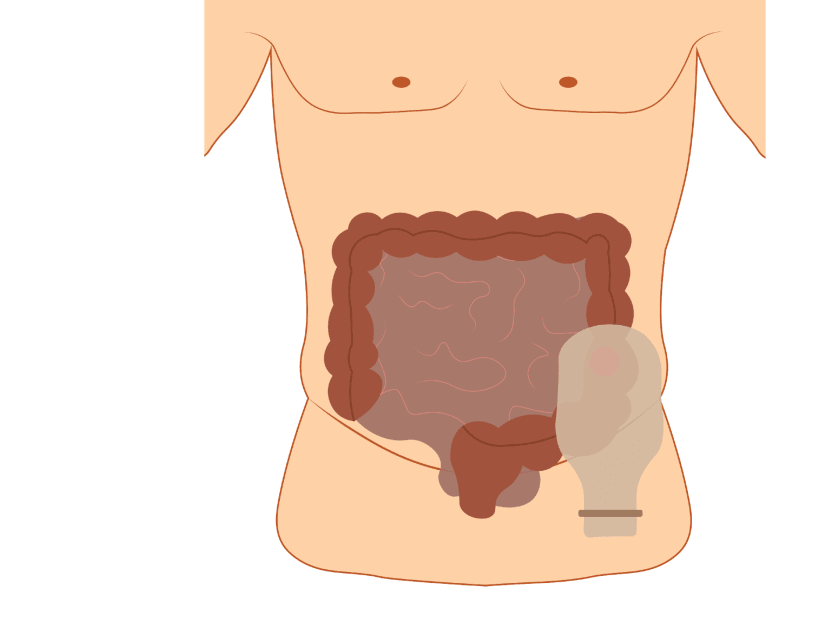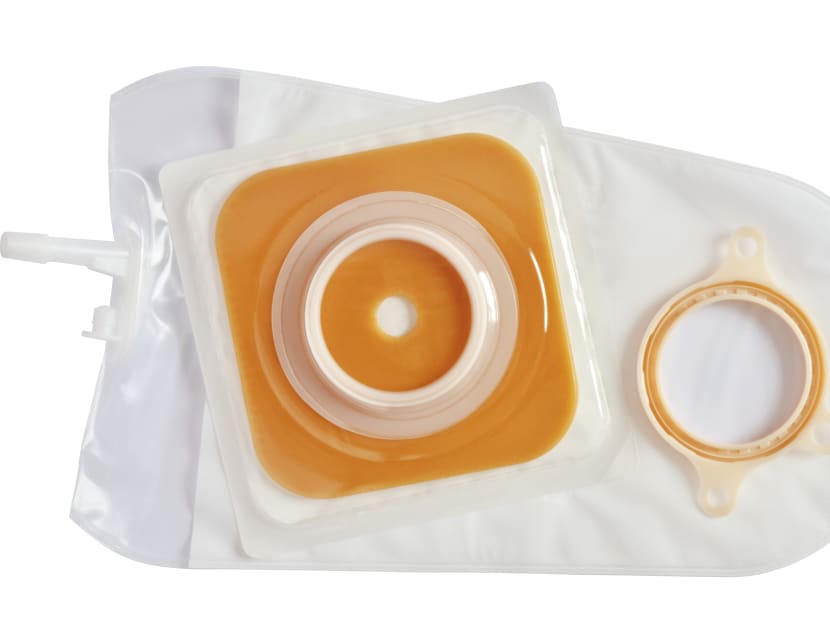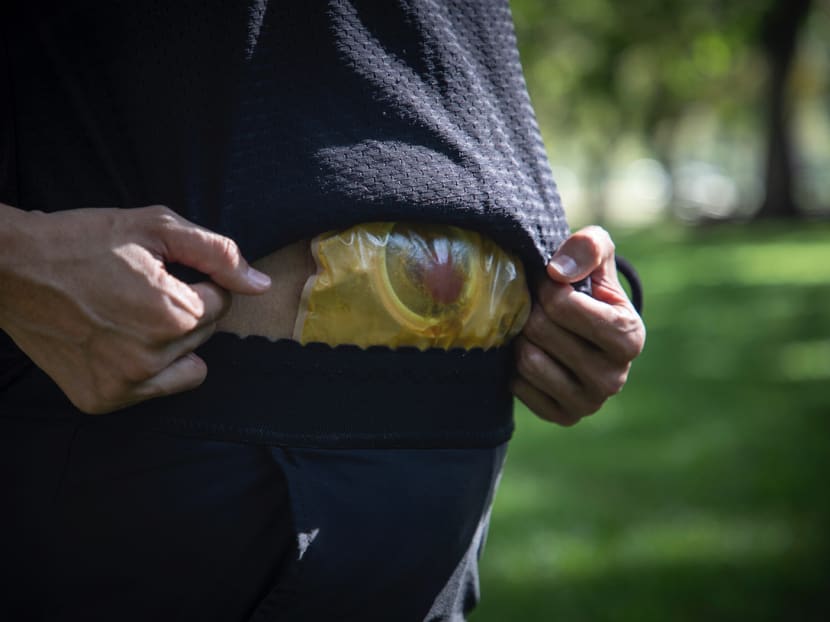Living with a stoma pouch: What a 39-year-old colorectal cancer survivor and doctors want you to know
SINGAPORE — At just the young age of 18, Ms Debbie Koh had her large intestine removed as a preventive measure against getting colon cancer. Even after that precautionary procedure, she could not escape cancer.
- A 39-year-old colorectal cancer survivor talks about her experience living with a permanent stoma
- A stoma is a surgically created opening on the abdomen's surface to divert the flow of faeces, which goes into a pouch
- In Singapore, colorectal cancer is among the common conditions that may require a stoma
- People often find it hard to accept it at first and face challenges adapting
- Education, counselling and support help patients cope better
SINGAPORE — At just the young age of 18, Ms Debbie Koh had her large intestine removed as a preventive measure against getting colon cancer.
She has a rare inherited disorder known as familial adenomatous polyposis, which causes polyps in colon and rectum that can become cancerous.
Even after that precautionary procedure, she could not escape cancer.
After experiencing frequent bouts of high fever and bloody stools, Ms Koh was diagnosed with Stage 2 colorectal cancer in 2018. She was only 36 then.
At the same time, she also had to come to terms with another devastating news.
The surgery to remove the cancerous mass located in her anal region would also involve removing the rectum and closing up the anus.
This means she would no longer be able to pass out stools normally and has to live with a stoma. This is a surgically created opening on the surface of her abdomen to divert the flow of faeces, which is collected in a pouch placed over it.
A stoma can be temporary or permanent. In Ms Koh’s case, hers would be irreversible and for life.
Recalling the disbelief and fear at the time, Ms Koh, now a 39-year-old teacher, said: “I was really so devastated by the bad news. It was hard to pick myself up. My parents could not face the fact that I have to live the rest of my life with a permanent stoma.”
It took her five days to come to terms with the grief and ready herself emotionally for the surgery.
‘A CHOICE BETWEEN SURVIVAL AND DEATH’
By opening up about her experience, she hopes to change negative perceptions and break the stigma surrounding a stoma.
“For me, it was really making a choice between survival and death, and anyone would choose survival,” Ms Koh said.

With colorectal cancer the most common cancer in Singapore, Ms Koh’s experience as an ostomate – a term that refers to a person living with a stoma – is not unique.
However, not many cancer patients or survivors are as accepting of their altered bowel function and the profound changes in their life.
“Some young people are very resistant against having a stoma, but why? Would they rather die?” Ms Koh asked.
“In the past, I thought that having a stoma is a handicap but now that I’ve experienced it, I embrace my life with it. I want to empower more people and let them know that it is nothing to be ashamed about.”
WHEN A STOMA IS NEEDED
So what about this daunting procedure that people need to know and how does it affect a person’s life?
Colorectal surgeon Lai Jiunn Herng, director of Lai Endoscopy and Colorectal Surgery at Mount Elizabeth Medical Centre, said that a stoma may be created to relieve intestinal blockage that occurs due to cancer.
In Singapore, the majority of colorectal stomas are being created as part of rectal cancer treatment, Dr Lai said.
Other types of cancer that may require a stoma include gynaecological cancer or bladder cancer that involve the colon or rectum.
A stoma may also be created due to inflammatory bowel diseases such as Crohn’s disease or ulcerative colitis, infection of the colon and severe trauma to the abdomen due to an accident.
It may be a temporarily measure to protect an area of healing after removing and re-attaching part of the colon or rectum, for example.
“Temporary stomas are typically closed between six weeks and six months later. Once that is closed, patients will be able to have intestinal function with bowel movement through the anus,” Dr Lai said.
“A stoma is permanent when it is deemed unsafe to reverse the procedure, or when there is no longer any continuity of the colon or anus due to the disease.”
However, permanent stomas are becoming less common due to advances in medical treatment and surgical technique, Dr Lai said.
WHAT PATIENTS FIND HARD TO MANAGE
Patients who require a stoma often find it hard to accept it at first and to get used to their “new normal”, Dr Lai said.
Regardless of their age, common hurdles that patients face include the challenge of recovering from treatment of their disease, issues related to the care and management of their stoma pouch and the emotional effects.
There are also extra costs involved in living with a stoma.
For instance, patients will need to change their stoma appliances such as stoma bags and adherent wafers to fit the stoma bags regularly, and also buy skincare products. These can add up to around S$150 to S$200 a month, Dr Lai said.
He added that the cost of a stoma and wound care session at a private clinic may start from around S$80 to S$100 while care at outpatient clinics in restructured hospitals may be more affordable.
However, once patients can look after their stomas more independently, there will be no further costs aside from the appliances.

Ms Jocelyn Low, senior nurse clinician at ConvaCare Clinics, a private practice at Novena Medical Centre offering specialised wound and stoma care, noted that based on her interactions with patients, each individual copes differently.
“For older patients, the main challenge is related to the care of the stoma itself because some of them have limitations in performing basic everyday activities. Their aged skin may also be more susceptible to skin irritation from the stoma,” she said.
Dr Lai said that older patients may have more difficulties with basic management of stoma hygiene also because manipulating the stoma appliance need hand-eye coordination, which they may lack.
On the other hand, younger patients may have difficulties overcoming their fears about their body image and adjusting to more active work or physical activities.
Ms Low said studies showed that people living with a stoma commonly report emotional and mental fallouts such as depression over their altered body image, anxiety, fear and anticipated isolation from their usual social groups.
Dr Lai said: “Emotionally and mentally, they tend to face the issue of acceptance; firstly self-acceptance and then understanding from their family and friends.
“They fear that it will smell or that it will be visible externally. They can be afraid of the inadvertent spillage of faecal contents in social situations and may be homebound due to this.”
Many patients also have the perception that they cannot go about their normal activities while living with a stoma, which is not true, he added.
HOW TO RESUME PHYSICAL ACTIVITIES
For Ms Koh, she said that talking to a nurse specialising in stoma care helped ease her initial fears and anxiety.
After recovering from her major surgery and adapting to the changes in her bowel habits, Ms Koh was able to resume activities that she loves such as yoga, swimming and jogging.
“My life has definitely changed after having a stoma but that does not mean that I can’t do the things I love. I just have to plan ahead and make adjustments,” she said.
For example, if she intends to go for a swim or arrange for a massage, she schedules the activity before breakfast and avoid eating foods such as onions that may release more gas through the stoma and cause the pouch to bulge.
“And instead of wearing a two-piece swimsuit, I now wear a one-piece. I still want to look nice so I try to look for swimsuits that has some gathers at the waist so that the pouch is not so obvious.”
She refrains from carrying heavy loads of more than 3kg to avoid straining the stoma area. Ms Koh wears slightly looser clothing to give allowance for the stoma bag to inflate.
The stoma makes some loud sounds when it lets out gasses and this is not something she can control. After eating, the pouch will bulge and this can also be quite obvious under clothing.
“All of these can be very embarrassing when you’re out on public transport for at a restaurant, for example. But over time, I learnt to get used to it,” she said.
To keep the pouch flat under her clothing, she drains the contents regularly throughout the day.
She replaces the pouch every five to seven days and the baseplate every 10 to 14 days . The baseplate adheres to the skin around the stoma, helping to protect the skin from the stoma output.

In spite of the precautions, Ms Koh has experienced some embarrassing incidents. Last year at work, the contents of the stoma pouch leaked because her waist band was too tight.
“I had to continue teaching for about half an hour before rushing to the toilet to change it. I was really self-conscious and worried that the smell (from the contents of the stoma pouch) may disperse, but thankfully, no one noticed,” she said.
Having said that, Ms Koh considers such incidents “inconveniences”, compared to the benefits of being able do the things that she still loves.
Her family, friends and colleagues have all been very supportive. Her mother, in particular, is very proud of her being able to handle the care of the stoma on her own.
At work, her colleagues would keep a lookout for her and would help her carry heavier items.
WHAT PATIENTS CAN DO TO ADAPT
Dr Lai said studies showed that education and counselling of patients and their caregivers before and after the operation result in better stoma care and outcomes.
He is of the view that there is a need for more widely accessible stoma care services in Singapore.
“The first few months after ostomy surgery is very critical because the ostomate and family members undergo a major transition to a new way of life.
“The professional care and support from specialised stoma care clinics can really smoothen the adjustment period,” he said.
Ms Low of ConvaCare Clinics, which provides both clinic and home-care services, said that emotional support is important, too.
“Support groups are an important aspect of managing a stoma. Fears of their current situation or of the unknown are often soothed when hearing and learning from those who have gone through a similar experience.”
The Ostomy Association of Singapore, a non-profit organisation, is an example of an outreach support organisation providing emotional support, education and practical information to stoma patients, Dr Lai said.
For patients who cannot go the private route for their stoma care, Dr Lai said that they may link up with their hospital’s stoma care services. They may also contact the Ostomy Association of Singapore for help.
“Once patients are empowered to care for their own stomas, they can be a source of education for other patients and even healthcare personnel,” he said.

Having lived with a stoma for more than three years, Ms Koh said that she has a different outlook on life. Despite her health ordeal, she is now a happier person and actively volunteers at the Singapore Soka Association, a Buddhist organisation.
“Before cancer, work used to be my top priority. I had poor stress management and ate unhealthily,” she said.
“Today, I want to embark on a more fulfilling life through my journey as an ostomate. I’m now also a firm advocate for healthy work-life balance.”
Besides her family and husband, Ms Koh is grateful to her doctor and the healthcare staff members who had supported her on her recovery journey.
The journey is not over. She is still on chemotherapy to shrink a desmoid tumour that was pressing against her left kidney. While desmoid tumours are not considered cancerous, they can grow in size aggressively.
Ms Koh knows there is a chance that cancer might recur. “But right now, I just want to live my life with gratitude and happiness and create value for others.”







